The 37-month Korean War (1950-1953) took a heavy toll on American troops: more than 36,500 died and over 92,000 were wounded. The very first American combat casualty was 19-year-old Private Kenneth Shadrick, a member of a bazooka team killed by enemy machinegun fire.
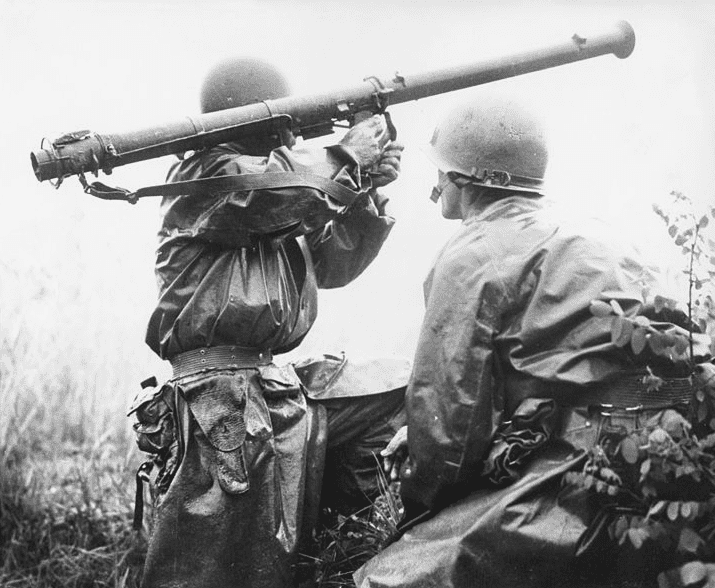
Shadrick died during the Battle of Osan on 5 July 1950, the first major clash of the war between U.S. and North Korean troops. That opening battle resulted in a North Korean victory, as the American troops were routed and the United States was jolted into realizing the magnitude of the war effort that lay ahead.
The Korean War began when 89,000 North Korean troops crossed the 38th Parallel to invade South Korea on 25 June 1950. They overwhelmed the 38,000 South Korean troops defending the border, and three days later the South Korean capital of Seoul fell. Alarmed, the United Nations Security Council decided to intervene and stop the Communist invasion, with the United States military taking the lead.
At the close of World War II just five years earlier, the U.S. had the strongest, most advanced and best-equipped military force in the world. However, five years of peacetime budget cuts had diminished that military might, and the best the U.S. could initially do to stop the North Korean onslaught was rush some undersized, under-equipped units from the 24th Infantry Division stationed in Japan.
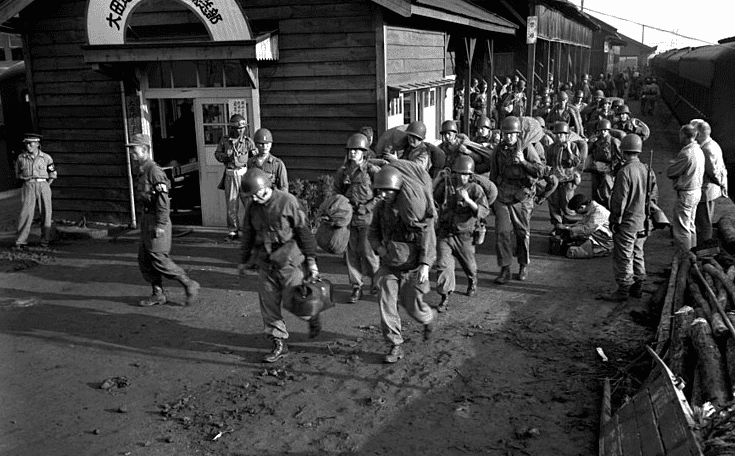
The first men sent to Korea were led by Lieutenant Colonel Charles B. Smith, a veteran of the Battle of Guadalcanal during WWII. The group, named Task Force Smith, consisted of 406 soldiers backed by another 134 men in an artillery battalion. Their near-suicidal mission: somehow delay the onrushing North Koreans long enough for the rest of the 24th Infantry Division to arrive.
On 4 July 1950, Task Force Smith dug into some hills north of Osan, about 25 miles south of Seoul, and waited for the enemy. They did not have to wait long. At 7:30 the next morning, July 5, eight North Korean (Russian-made) T-34 tanks rumbled into view. To their horror, the Americans quickly realized their outdated bazookas, and the inferior shells of their artillery, could not pierce the tanks’ armor. An hour into the desperate fight, another 25 North Korean T-34 tanks joined the fray. Then, around 11:00, 5,000 North Korean infantry arrived on the scene, and the Americans were hopelessly outmanned and outgunned.
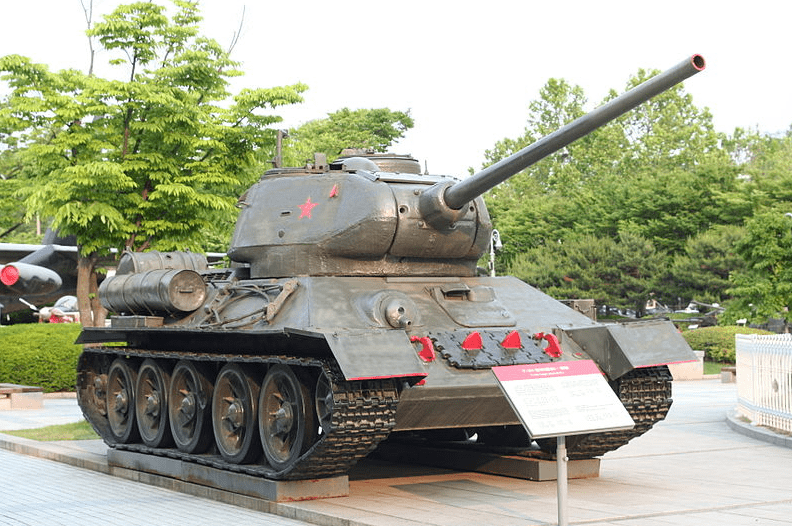
Nonetheless, Task Force Smith bravely fought on, holding off the North Korean advance for another three hours. They did all they could but it was not enough, and Smith eventually ordered a retreat that started in orderly fashion but fell apart due to confusion and poor communications. Much equipment and some wounded Americans were left behind – it was later discovered that the wounded had been shot where they lay in their litters, and some captured U.S. soldiers were found executed, their hands bound behind them.
In all the U.S. suffered more than 160 casualties out of its total force of 540 men in the Battle of Osan. Their resistance in the face of overwhelming odds showed the fighting spirit of the American soldier, but their shortcomings in numbers and equipment taught the U.S. military some important lessons. Later forces would be larger and better equipped, but ultimate victory could not be achieved and the war settled into a bloody three-year stalemate.
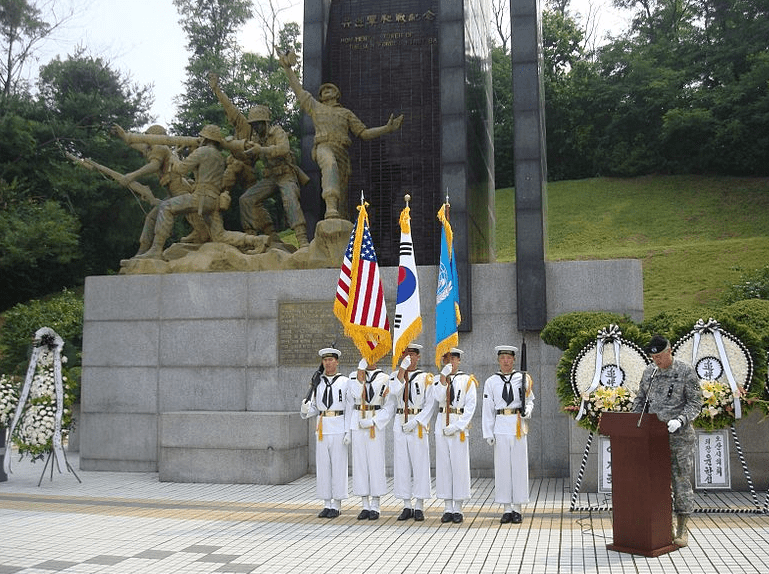
What began as a civil war became an international conflict involving the superpowers and their allies. Eventually, the Korean War pitted the Democratic People’s Republic of Korea (North Korea), the People’s Republic of China, and the Soviet Union against the Republic of Korea (South Korea), the United States, and 15 United Nations allies. Ultimately, neither side prevailed.
An armistice was signed on 27 July 1953, finally halting the fighting in the Korean War. A bloody, destructive proxy war in the Cold War struggle between the United States and the Soviet Union, the Korean War caused millions of casualties yet the border remained unchanged: the armistice left the two Koreas divided at the 38th parallel, just as they had been when the war began. Today, a 2.5-mile-wide demilitarized zone separates North and South Korea, with sporadic incidents of trespass and violence leaving the entire area in a perpetual state of mistrust and anxiety.
The following three newspaper articles are about the Battle of Osan. The first article is a news report of the battle, the second reports on the first American soldier killed in the war, and the third is an account from a war correspondent who accompanied the troops on the front line.
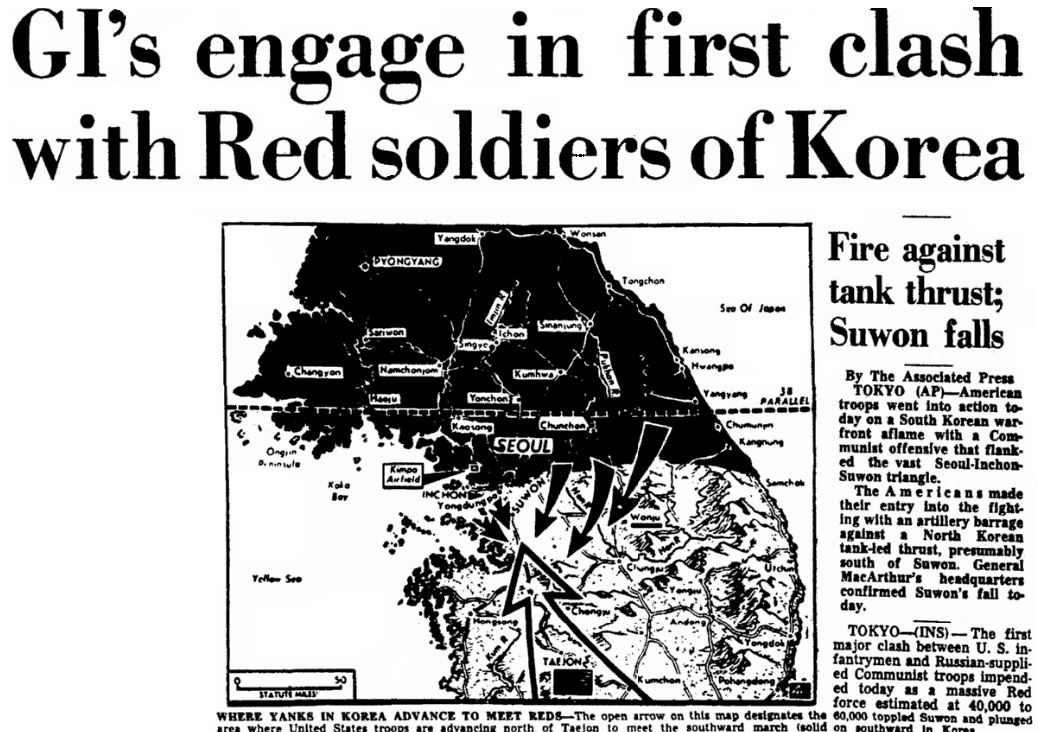
Here is a transcription of this article:
GI’s Engage in First Clash with Red Soldiers of Korea
Fire against Tank Thrust;
Suwon Falls
By The Associated Press
TOKYO – (AP) – American troops went into action today on a South Korean warfront aflame with a Communist offensive that flanked the vast Seoul-Inchon-Suwon triangle.
The Americans made their entry into the fighting with an artillery barrage against a North Korean tank-led thrust, presumably south of Suwon. General MacArthur’s headquarters confirmed Suwon’s fall today.
TOKYO – (INS) – The first major clash between U.S. infantrymen and Russian-supplied Communist troops impended today as a massive Red force estimated at 40,000 to 60,000 toppled Suwon and plunged on southward in Korea.
A dispatch telephoned to Tokyo by Ray Richards, International News Service staff correspondent at field headquarters in Korea, said:
“A sense of expectancy hung as heavy as the rain clouds gathered over Korea today and an American Army spokesman indicated there certainly would be important action between Americans and Communists.”
Suwon Falls
Suwon, key rail and communications city, fell to tank-paced North Korean troops which plunged onward and threatened the port of Inchon in a pincer movement threatening to trap thousands of South Korean defenders.
Weakened South Korean troops and numerically inferior American infantrymen faced the onrushing Communists who have been fed more tanks and supplies.
U.S. infantrymen entered the Korean fighting for the first time in a Fourth of July skirmish in which they joined with South Korean soldiers to repel the invaders at a rail line and railroad station.
No Casualties
The number of Americans involved in their initial clash and the extent of the battle were not disclosed, but a communiqué early today from General Douglas MacArthur’s headquarters mentioned no U.S. casualties.
American strength on the Korean peninsula is being reinforced swiftly. Reports today mentioned 60 new planeloads of troops and equipment being flown to Korea from Japan.
Air force planes continued to hammer at the invaders and the navy blasted North Korean shipping and installations, but on the ground the Communists definitely held the upper hand.
Grim Aspect
The fall of Suwon and its adjacent air strip lent a grim aspect to the military situation at the front. Suwon is 22 miles south of Seoul, the Communist-held South Korean capital.
The North Koreans were attempting a gigantic pincer movement which threatened the encirclement of all South Korean forces in the Inchon-Seoul-Suwon triangle. Inchon is the main port city southwest of Seoul.
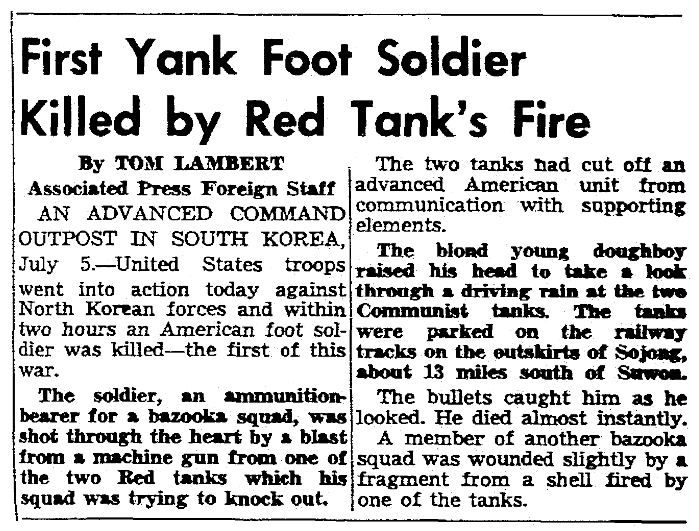
Here is a transcription of this article:
First Yank Foot Soldier Killed by Red Tank’s Fire
By Tom Lambert
Associated Press Foreign Staff
AN ADVANCED COMMAND OUTPOST IN SOUTH KOREA, July 5. – United States troops went into action today against North Korean forces and within two hours an American foot soldier was killed – the first of this war.
The soldier, an ammunition-bearer for a bazooka squad, was shot through the heart by a blast from a machine gun from one of the two Red tanks which his squad was trying to knock out.
The two tanks had cut off an advanced American unit from communication with supporting elements.
The blond young doughboy raised his head to take a look through a driving rain at the two Communist tanks. The tanks were parked on the railway tracks on the outskirts of Sojong, about 13 miles south of Suwon.
The bullets caught him as he looked. He died almost instantly.
A member of another bazooka squad was wounded slightly by a fragment from a shell fired by one of the tanks.
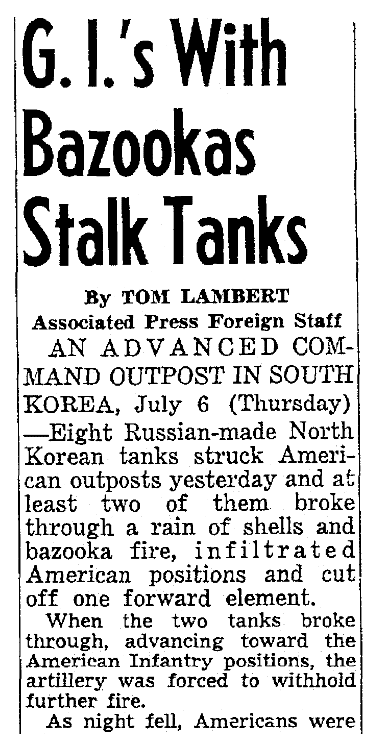
Here is a transcription of this article:
G.I.’s with Bazookas Stalk Tanks
By Tom Lambert
Associated Press Foreign Staff
AN ADVANCED COMMAND OUTPOST IN SOUTH KOREA, July 6 (Thursday) – Eight Russian-made North Korean tanks struck American outposts yesterday and at least two of them broke through a rain of shells and bazooka fire, infiltrated American positions and cut off one forward element.
When the two tanks broke through, advancing toward the American infantry positions, the artillery was forced to withhold further fire.
As night fell, Americans were firing heavy mortars at the tanks, which were parked menacingly near the railway station at Sojong, about 13 miles south of Suwon.
American infantrymen and bazooka squads fought a four-hour battle with the tanks this afternoon without knocking them out.
The battle was witnessed by this correspondent, Carl Mydans of Time and Life, Marguerite Higgins of The New York Herald Tribune, Dennis Warner, Australian journalist, and Andrew McCartney of Reuters, British news service.
We arrived at an American command post early yesterday in a downpour of rain just as the senior officer slithered through the mud with information about the tank breakthrough.
The command post was in a squalid little Korean farmhouse.
The senior officer unfolded a crackling map on the porch floor and pointed to the breakthrough area.
“This is the first time North Koreans have met American troops and I think they are going to get quite a shock out of it,” he declared.
“We must find those tanks and knock hell out of them.”
Clutching a “grease gun” (submachine gun) in one hand and a pipe in another, the officer directed that bazooka squads be ordered out to hunt and kill the tanks.
The command post erupted into action. A sergeant called up the headquarters’ bazooka squad and relayed the orders while standing in a pelting rain which ran off the roof in a stream and hissed into a dirty puddle.
‘Let’s Go, Jack’
A lanky G.I. with his bayonet stuck into his boot-top and tied to his leg with a bit of grass rope shrugged into his raincoat and picked up the long slender steel tube known as the bazooka.
“Let’s go, Jack,” Slim said calmly to another soldier.
The bazooka squad moved out, the little team slithering in the mud. They moved out past gun emplacements, past infantry positions into a countryside strangely quiet except for the drum of the rain.
As they moved north they met many Korean soldiers fleeing south.
About a mile from Sojong the cavalcade halted and bazooka-squad soldiers entered the thick shrubbery at the roadside. First Lieut. Charles Payne, 29 years old, Neosho, Mo., commander of the tank-killer team, vaulted out of his jeep, carbine in hand.
Suddenly the word came back: “Tanks approaching.”
The men dug in. Payne snaked forward toward the edge of the road and advanced warily.
There was a long period of quiet, except for a shell now and then. We edged forward quietly and encountered Payne holding a 75 mm shell casing.
Had he seen the tanks?
“Certainly,” Payne replied. “He shot this at me,” nodding at the shell casing. “I’m going to get my bazooka boys after him.”
Payne ran back to his squad.
We moved up the road to where the tank had appeared, parked briefly, then turned around and headed back for Sojong.
It had been a big one. It was seven feet between treads. Its cleats had bitten deeply into the rocky road.
The bazooka squad moved up. A few Korean soldiers went along. We took positions in a cluster of Korean grave mounds. We could not see the tanks – yet. Then we shifted forward through the grave mounds and suddenly there was a cry – “tanks!”
One of them sat on some railway tracks, possibly disabled mechanically but not in its venom. It was squarish-looking, with a flat-top turret from which protruded a long-barreled gun.
More bazooka men moved up. From nearby on the grave mound there was a bazooka flash, and then the rocketing thump as the shell struck. A bazooka man, Pvt. Alfred Beauchamp, New York, had scored a hit or a near-miss.
The tank ripped out a blast of machine-gun fire.
A handful of Korean soldiers edged nearer the tank, behind which loomed a second. The Southerners said the North Koreans invited them to cross over and quit fighting “because we’re all Koreans.”
For nearly two hours we watched the battle.
Occasionally the tank swung its turret like a cobra weaving for a strike. Once, stung by fire coming from the grave mounds, it blasted a 75 shell into them.
Darkness fell. The gloom matched that of the Americans who hadn’t been able to knock out the tanks. The bazooka men withdrew. Mortar teams came up. They were firing for range when we left.
Note: An online collection of newspapers, such as GenealogyBank’s Historical Newspaper Archives, is not only a great way to learn about the lives of your ancestors – the old newspaper articles also help you understand American history and the times your ancestors lived in, and the news they talked about and read in their local papers. Did any of your family serve in the Korean War? Please share your stories with us in the comments section.

My dad was there. He served in the 24th. Luckily he came back home uninjured, however, his brother did not. Thanks for the articles.
Sorry to hear about your Uncle, but good to hear your Dad made it back unharmed!